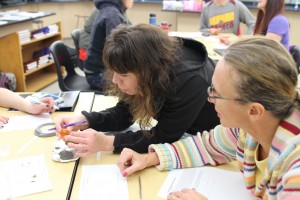
Hundreds of teachers from across the state convened in Sitka last weekend for the Alaska Math and Science conference.
This was the first time the biennial professional development summit was held in Southeast.
Several sessions addressed how teachers can keep curriculum culturally relevant and fun while still helping students meet new educational standards.
In the past, Blatchley Middle School teacher Bridgette Whitcomb had to order all of the meteorites for her earth science classes from the internet.
“On Ebay you can buy lots of meteorites and so the kids get to see the meteorites I buy online,” Whitcomb said. But, “you can’t buy moon rocks online.”
After the Alaska Math and Science Conference, she’ll be able to borrow tiny pieces of the moon from the Johnson Space Center in Houston, Texas. Whitcomb and dozens of other Alaska teachers became certified to check out the materials from NASA.
Part of that process involved playing games they could use in their own classrooms. In one, they identified pictures of moon fissures and lunar soil or regolith. They also tested an artificial mars soil.
“It feels like sand”
And they talked about how these space rocks could fit into their lesson plans – and potential new educational standards.
“These are just some the next generation science standards that it covers: Physical science, history of our planet, physics if you teach high school,” NASA educator Maria Chambers, who taught the seminar, said.
So far, 14 states and the District of Columbia have adopted the controversial standards – Alaska is not among them.
The new state standards for math and teacher accountability were big topics during the sessions. The conference’s theme after all was “Navigating the Tides of Change.”
Organizer Rebecca Himschoot, who teaches science at Keet Gooshi Heen Elementary School, says there are so many variables in education right now. That’s why conferences like this one are so important.
“Standards are one part of the conversation,” Himschoot said. “A much bigger part of the conversation at a conference like this is teachers teaching other teachers how best to get to those standards.”
Himschoot says there are going to be a couple rough years ahead as educators learn how to teach to the higher standards.
“We want to get from A to B as fast as possible and it’s not going to be a straight line,” Himschoot said. “We need opportunities like we had this weekend to help teachers to find the best ways to make greatest gains we can as fast as we can—without taking fun out of it and without forcing kids to do things that they don’t find valuable.”
Educators are also being evaluated on their students’ learning –and eventually how they make subjects culturally relevant. To that end, the conference had sessions on how to incorporate math and science into Iditarod lesson plans and or use moose population case studies in science classes.
All in all, teachers seem pleased with the new state standards. Matt Hunter, who teaches math and science at Mt. Edgecumbe High School, says the new expectations have not changed how he teaches.
“I see the standards as a resource but I don’t see them as a threat at all,” Hunter said. “I still do what I judge to be best for my students.”
“It’s just another way to make sure that students in the United States are getting a good education no matter where they are.”
No matter where they are – from Barrow to Ketchikan.
While Sitka teacher Whitcomb is looking forward to getting actual moon rocks in her classrooms, the conference provided more than just that. She says it gave her an invaluable opportunity to compare notes with other educators.
“To be able to be exposed to science teachers who are teaching the exact same thing I am and how they do is really awesome because here I am the only one who does it on the island,” Whitcomb said.
That’s Baranof Island.
The next Alaska Math and Science Conference will be in 2017 in Fairbanks.




